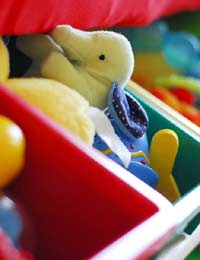Choosing Quality Equipment for Day Nurseries

When choosing kids furniture, toys, and other equipment and supplies for a day nursery or other type of childcare facility, it's important to remember that it is often more cost efficient to choose high quality products. While it can be tempting to choose cheaper items, especially in the beginning when there are so many purchases to be made at once, but in the long run, investing is high quality teacher supplies usually saves money.
Planning and Prioritising Daycare Equipment Purchases
When opening a childcare business, initial expenses can be considerable. Buying or leasing a building, making modifications to maximize the usability for children of varying ages, cots, bedding, kitchen items, toys, outdoor playground equipment, books, and assorted educational supplies can be costly, taking a large bite out of allocated start-up costs. There are other expenses, of course, such as licensing costs, advertising, and office supplies, and when the costs are tallied, many potential nursery owners feel a bit deflated, wondering how they'll manage. It can be tempting (and even necessary) to cut corners here and there, but it's important to exercise caution when deciding where to trim expenses.Considering Equipment Safety
The single most important factor for all day nursery equipment is safety. Choosing playthings and equipment that display one of the standard safety marks can provide some assurance that the items will perform well and not put children at unnecessary risk. Some of the basic marks include:- The CE Mark: This mark has been required to be placed on all toys placed in the market in the European Union since January 1990. While it doesn't necessarily indicate a highly rated item, it does show that the product meets the safety requirement of the European Toy Safety Directive.
- The Lion Mark: Developed by the British Toy & Hobby Association in 1988 to indicate toys that have met strict standards of both safety and quality.
- The Kite Mark: Products carrying the Kite Mark indicates that they have been independently tested to be sure that they perform up to par in accordance with expectation set by the British Standards Institution. Parents and professionals can rest easy when choosing products bearing the Kite Mark, as they should be safe and reliable.
While safety marks are helpful, it's important to remember that proper assembly and maintenance of all children's products is vital. Kids' furniture and outdoor playground equipment can be especially dangerous if they are not put together well and used in accordance with the manufacturer's specifications. Many toys and other children's products come with guidelines for use by children if specific age groups and these recommendations should be heeded. They are typically put into place not to indicate which ages of kids will enjoy the products, but instead which are likely to be developmentally ready to use them safely and appropriately.


Re: What Licence do I need to Operate a Nursery?
Hi,I am interested in opening up a nursery.i have worked as an administrator for the NHS for 10 years. Just…
Re: What is a Montessori Nursery?
Hi, I needed guidance, in order to open a Montessori nursery. I am a stage 4 qualified Montessori teacher with an experience of…
Re: What Qualifications Are Needed to Run a Nursery?
Hi I have 13 years in health and social care for adult and about a year for children in respite care. I…
Re: How to Ensure Sufficient Staff Coverage at Day Nurseries
I know someone who works in a nursery where She is left alone with 8 children who range from…
Re: What Licence do I need to Operate a Nursery?
Hi, I worked as nursery/primary/secondary schools administrator and in HR. I am interested in opening a…
Re: What Qualifications Are Needed to Run a Nursery?
I am an Indian. What qualification would need to become a owner & teacher of nursery school?
Re: What Licence do I need to Operate a Nursery?
Bushra - Your Question:I am a qualified primary teacher ( 5-11 years). It has always been a dream of mine to…
Re: What Licence do I need to Operate a Nursery?
I am a qualified primary teacher ( 5-11 years). It has always been a dream of mine to set up my own nursery…
Re: What Qualifications Are Needed to Run a Nursery?
What qualifications is needed to open a day nursery in Northern Ireland
Re: Tips for Setting Fees at Your Day Nursery
Hello, I am wanting to set up a day nursery. I am a qualified secondary school teacher with 4 years experience. I…